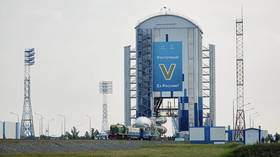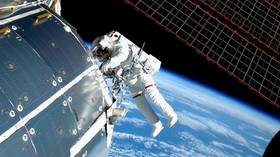Russia reignites space race with historic lunar mission

Russia has successfully launched a probe to the Moon for the first time since 1976. Luna-25 blasted off from the Vostochny spaceport in the far-eastern Amur Region on Friday morning, and is aiming to touch down on the southern polar region of Earth’s satellite by August 21.
The potentially historic mission comes as rival nations – such as the US, China and India – are also seeking to be the first to find a reliable water source on the Moon. Such a discovery would be key to one day building a permanent lunar human settlement.
All previous probes have landed in the equatorial region of Earth’s satellite. If successful, Luna-25 would arrive two days before India’s Chandrayaan-3, for a historic first landing in the rugged polar terrain.
Luna-25 is the first Moon probe made in modern Russia, entirely from domestic components. The USSR launched 24 official ‘Luna’ missions between September 1958 and August 1976.
The probe’s objective is to carry out scientific research in the southern polar region of the Moon. Luna-25 is equipped with instruments for analyzing the lunar soil, plasma, and dust components for the presence of rare minerals. The designated landing site is near the Boguslavsky Crater and the mission is scheduled to run for one year.
According to Roscosmos, the crucial first phase of the mission will take nine minutes, from liftoff to the third-stage separation of the Fregat module, carrying the probe. The module is supposed to fire the main engine twice to set Luna-25 on a flight path to the Moon.
The flight itself is supposed to take five days, with two trajectory corrections along the way. The last phase will take about three days and set the probe on a circumpolar orbit at an altitude of around 100 kilometers. In the fourth phase, Luna-25 will switch to an elliptical landing orbit with a minimum altitude of 18km and carry out a soft landing in the south polar region.
India hoped to be the first to land in the polar mountains, in September 2019, but the Vikram lander of the Chandrayaan-2 probe lost connection and crashed. The Chandrayaan-3 mission, launched in July, is already in lunar orbit and aims for a polar landing by August 23.
The Soviet Union’s space program notched a number of historic firsts with the Luna probes. Luna-1 was the first spacecraft to leave the Earth-Moon system, in January 1959. In September that year, Luna-2 became the first manmade object to reach the Moon. Luna-9 performed a soft landing in February 1966, and Luna-10 became the Moon’s first artificial satellite that March.
Though lagging behind the Soviets in orbital exploration, the US claimed the first manned landing on the Moon, with Apollo 11 in July 1968. The Apollo program was discontinued in December 1972. The last Soviet lunar mission, Luna-24, returned samples of lunar soil to Earth for study in August 1976.













